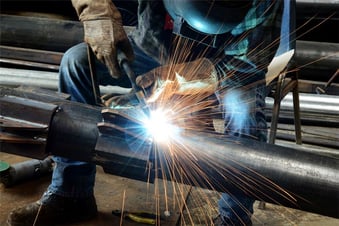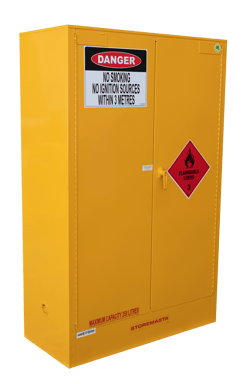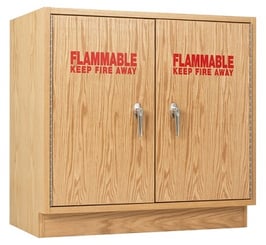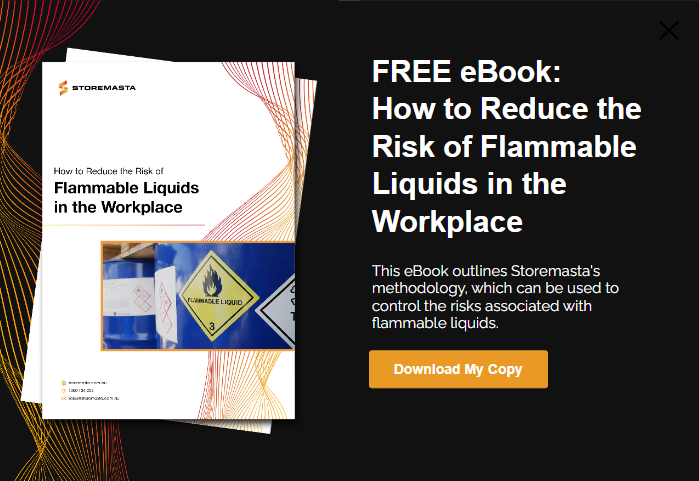Is your workplace storing packages of flammable liquids in cabinets constructed with plastic or wood? Many workplaces are unaware of the potential risks associated with storing flammable liquids such as petrol, acetone or paint. This lack of awareness can result in staff unknowingly storing flammable liquids in cabinets that don’t meet the WHS regulations.
If you are storing flammable liquids in wooden and plastic cabinets at your workplace, read on to find out why this is an unsafe and non-compliant method of flammable liquid storage.
Understanding Flammable Liquids
As the name suggests, flammable liquids are volatile substances that release flammable vapours at temperatures below 60 °C. This means that flammable liquids will ignite if they come into contact with an ignition source.
Ignition sources can fall into four categories: thermal, electrical, mechanical and chemical. A broad range of tools, equipment, electrical appliances and other commonly found workplace items can act as an ignition source for flammable liquids.
Workplace ignition sources may include:
- Lighters Cigarettes
- Open flames
- Pilot lights
- Ovens
- Cooktops
- Welding equipment
- Grinding tools
- Electric motors
- Electric switches
- Combustion engines in machinery
… and the list continues.

Even welding equipment can be an ignition source
If these substances came into contact with an ignition source, they will ignite and spark a blaze that could harm people, property and the environment. To minimise the potential for damage or prevent these hazardous incidences from occurring altogether, it’s vital that workplaces make sure that flammable liquids are stored in a safe and compliant manner.
What Is A Compliant Flammable Liquids Cabinet?
The Australian Standard that is applicable for the storage of flammable liquids is AS 1940:2017 – The storage and handling of flammable and combustible liquids. This standard outlines the specific storage cabinet requirements for this class of dangerous goods.
The standard clearly details the requirements for cabinet construction – including the materials that are required to create a compliant flammable liquids cabinet.
AS 1940:2017 states that:
4.9 STORAGE IN STORAGE CABINETS
4.9.2 Cabinet construction
The following requirements apply:
(a) The walls, floor, door and roof shall be of double-walled sheet steel construction, with a space of at least 40 mm between the walls. NOTE: This space may be either an air space or filled with non-combustible insulation.
The standard goes on to state:
(h) The materials of any components that are critical to the cabinet’s structural integrity shall not melt at temperatures less than 850°C. Seals or gaskets are excepted, but their use should be avoided if their failure could affect the protective function of the cabinet.
To summarise the points listed in the Australian Standard:
Compliant cabinets MUST be made with materials that won’t melt at less than 850°C (seals or gaskets excepted). The walls, floor, door and roof of the cabinet must be constructed with double-walled sheet steel to meet the requirements of AS 1940-2017. This means that cabinets made from plastic or wood are not compliant for flammable liquids storage.
Why Are Wooden Or Plastic Cabinets Unsuitable?
The reason why plastic and wooden cabinets are unsafe for the storage of flammable liquids is because they don't provide enough protection against the risks that flammable liquids have upon the workplace.
A flammable liquids storage cabinet is intended to:
- Contain spillages
- Protect the flammable liquids inside the cabinet from damage
- Provide segregation between incompatible substances
- Protect the flammable liquids in the event of a fire, allowing enough time for staff to escape or firefighting equipment to be used for fire containment
 Compliant flammable liquids cabinets provide risk minimisation features
Compliant flammable liquids cabinets provide risk minimisation features
If a flammable liquids storage cabinet is constructed from a combustible material — such as plastic or wood — it will lack the ability to adequately protect the workplace from the risks associated with flammable liquids.
What Are The Risks?
So, what makes plastic or wooden cabinets unsafe for flammable liquids storage? Read on to find out more about the risks involved with non-compliant storage cabinets:
Wooden Cabinets Are Permeable
One reason why wooden cabinets are unsafe for storing packages of flammable liquids is because they are permeable. Permeable materials are materials that will allow liquids and gases to pass through it.
Therefore, when a flammable liquids storage cabinet is constructed from permeable material, it reduces its ability to:
- Contain flammable liquids spills
- Segregate flammable liquids from other incompatible substances
If flammable liquids spilled inside a wooden cabinet, the cabinet would not have the ability to contain the flammable liquid. The flammable liquid would seep through the wood and into the workplace. Uncontained flammable liquid spills increase the risk of slip and fall incidents. They can also spark fires or explosions if they meet an ignition source.
In addition to these hazards, there is always the risk that flammable liquids may leak and come into contact with incompatible substances. The mixing of incompatible substances is a serious workplace hazard as this can result in violent chemical reactions.
To avoid these risks, flammable liquids must not be stored in a cabinet made from a permeable material.
Inadequate Fire Protection
Another factor that makes plastic and wooden cabinets unsafe for the storage of flammable liquids is that plastic and wood are both combustible materials.
If plastic or wood are exposed to enough heat, they will start to burn. In the event of a workplace fire, a plastic or wooden cabinet would not protect the flammable liquids inside the cabinet from igniting. Because the cabinet will continue to burn, the flammable liquids inside would ignite. This would only intensify the workplace fire and greatly increase the risk of serious injury and property damage.
This ignition of flammable liquids would also prevent people in workplace from safely escaping the fire.
To prevent these hazards from occurring, flammable liquids must never be stored in a cabinet constructed with combustible materials such as plastic or wood.
 Unsafe and non-compliant way to store flammable liquids
Unsafe and non-compliant way to store flammable liquids
How To Safely Store Flammable Liquids
To safely store packages of flammable liquids in the workplace, you must follow all requirements as outlined in AS 1940:2017 — which includes the selection of a compliant cabinet and how it is used within your workplace.
In the event of a workplace fire, compliant cabinets constructed with double-walled sheet steel and allowing a 40mm air gap, will provide adequate protection against heat. This construction requirements prevents the flammable liquids from immediately igniting, which allows personnel in the workplace to safely escape the fire.
Steel is also an impervious material which will prevent flammable liquids spills from leaking into the workplace. The prevention of leaks is a fundamental element in the safe storage of flammable liquids.
Reducing Your Risks
As we’ve discussed in this blog, flammable liquids pose a range of serious risks to the people and property in your workplace. Therefore, it is crucial that you understand how to store and handle flammable liquids in a safe and compliant manner.
You can achieve full compliance by always storing your flammable liquids in a cabinet that has a double-walled sheet steel construction with a 40mm air gap between the walls. A cabinet that is not constructed to comply with the Australian Standard AS 1940:2017 can put your organisation at risk of financial liability due to non-compliance. However, there is more to know about compliant storage than what materials are required for the construction of a flammable liquids storage cabinet.
So, if you’re ready to learn about compliant flammable liquids storage or you’re interested in understanding how you can reduce your risks, please click on the image below to download your FREE eBook. Our resource will take you through all aspects of flammable liquids storage with a simple to understand methodology that you can apply to your workplace. Access our eBook and reduce your risks today.
Joining the team as a Dangerous Goods Storage Consultant, Melissa Hampton became Storemasta's Marketing Manager in late 2021. With extensive knowledge and experience in chemical compliance, Melissa is responsible for leading the Marketing team and helping shape their marketing strategy. In her spare time, you can find Melissa hiking, swimming and enjoying the great outdoors in beautiful north-west Tasmania.
